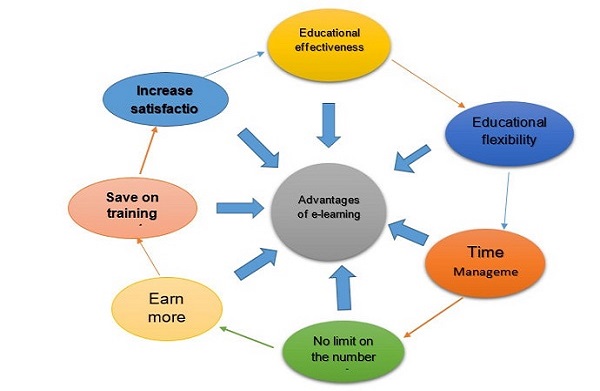The impact of training on the work system and manpower
Introduction:
attention to the rapid changes in the contemporary world and fierce competition
Organizations To access wealth resources, serious attention to human resources is an inevitable necessity. In this regard, it is very serious to pay attention to new approaches in manpower training because investing in training seeks to increase manpower productivity
Today, the progress and development of technology and upgrading the technology level of products depend on human science and knowledge. This has led organizations to put education at the top of their agenda. Because education is one of the most important factors in the development of countries
In recent years, the issue of productivity has become very important in our country, and both in academic and scientific circles and in executive circles, there is talk of productivity.
Training is a set of “deliberately arranged” events designed to support internal learning processes.
Training and development to prepare employees for new jobs has also become more important globally.
Training alone cannot make productive employees effective.
The best way to evaluate the effect of training is to consider it a tool.
A manager should also choose training as a tool for career development.

Training Cources :
- Production, distribution and consumption of steam in the dairy industry
- Sterile milk and dairy products (UHT)
- Use of powdered materials in dairy products
- Pasteurizer
- operator
- Separators, clarifiers and bactofuse in the dairy industry
- Homogenizer in the dairy industry
- Applied rheology and formulation of new linen products
- Methods of preparing and preparing the hygienic air of the production hall and processing machines
- Principles of selection, application, maintenance of valves and matrices in the dairy industry
- Use of stirrers in dairy processes
- Membrane systems and its application in the dairy industry
- Principles and applications of washing systems (CIP)
- Plumbing in the dairy industry
- Plate heat exchangers
- Centrifugal pumps and their application in dairy processes
- Concentrating pumps and its application in dairy processes
- Dairy tanks
- Fermented milk products
- Instrument usage period in dairy industry
- Processing of cream, butter, oil
Education Concept :
Training means all the efforts that are made to improve the level of knowledge and awareness, technical, professional and job skills, as well as to create desirable behavior in the employees of an organization and prepare them to perform and accept their job responsibilities.
Teaching is a pre-planned activity that aims to create learning in learners through interaction with a two-way relationship.
Training to change knowledge, attitudes and interaction with colleagues. Education is an effort to change the consciousness of individuals, which motivates the individual to acquire new consciousness, and nurtures in order to change habits and behaviors, and changes the intellectual direction and destiny of human beings.
Experiential learning based on learning and in order to create relatively lasting changes in the person, to enable him to do work and improve, abilities, change skills, knowledge, attitude and social behavior. Therefore, this training in the sense of knowledge change, attitude And interact with colleagues.
Purpose of training:
In general, the goal of any educational activity is to change the practical behavior of individuals that leads to increasing skills and knowledge among learners. So that employees can do their current job effectively and efficiently.
Training has goals such as developing skills, changing behavior and increasing competencies.
The objectives of the training are to identify the types of skill levels, abilities, knowledge and attitudes of the participants that are included in the complete training program. Divide the required skills into three groups: technical skills, communication skills And problem solving skills
Workplace education can be the solution to problems, but it is important to know what problems can be solved with it. Due to the incompatibility of business problems with the solutions that education offers to solve these problems.
Implementation of training and improvement of human resources allows people to effectively continue their activities in accordance with organizational and environmental changes and increase their efficiency.
The correct use of human resources, similar to the most valuable and greatest wealth of any society, has been considered as an important issue by organizations.

Training effects:
Entrepreneur training is the most powerful tool and process available to transfer skills knowledge to human resources and empower them to perform tasks.
Educated people have the right tools to deal with social deprivation and can make decisions that have a positive impact on their lives.
Training can build a general understanding of the organization’s goals, demonstrate management commitment and loyalty to employees, and prepare individuals to increase their responsibilities and participation in the organization in ways
Training is not effective in cases such as poor work structure, incompatibility of work with the person, uncertain powers and responsibilities, and other organizational issues.

Types of learning methods(education)
- Group and long training
- General or personal training
- Daily training
Need or desire for training
Education based on modern technology
Most training is given to people while serving. This is because in-service training is simpler and usually less expensive.
a) Higher education (university)
b) Pre-employment training (justification)
c) In-service training (formal)
D) Specialized training to accept a certain responsibility or profession
Here are four types of staff training:
Pre-service training: A person needs it before joining the organization in order to acquire the necessary skills to get a job
- On-the-job training: It is a training that in order to justify new employees and familiarize them with the process of the organization and its organization, the assigned tasks and laws and regulations related to various matters of the organization.
- In-service training: It is training that is provided to employees in the real workplace and at the same time while performing job duties, and this training helps people to be based on organizational, ethical, social expectations and according to individual issues and Organize to show appropriate behaviors.
- Post-service training: training that is provided to better prepare employees for retirement. This training helps retirees acquire income-generating skills, how to deal with the power vacuum caused by retirement, how to spend time in unemployment, and how to maintain and maintain physical and mental health.

Definitions and concepts of productivity:
- The word productivity means power and productivity.
- In studies on productivity by organizations and experts, several definitions of productivity have been provided. The following are some of these definitions..
- From the point of view of the Organization for Economic Co-operation and Development (OECD), productivity is the result of a deficit obtained by dividing the value of a product by the value of one of the factors of production. Based on this, we can talk about capital productivity, raw materials and labor.
- From the perspective of the National Productivity Organization of Iran, productivity is a culture and a rational attitude to work and life, which aims to make activities smarter to achieve a better life.
- In the Glossary of Productivity, which is an internal publication of the National Productivity Organization of Iran, productivity is expressed as follows: “Productivity to maximize the use of resources, manpower, facilities, etc. in a practical way. Reduce production costs, expand markets, increase employment and strive to increase real wages and improve living standards

Factors affecting productivity:
- The set of factors affecting the productivity of an organization consists of two main dimensions:
- A) External factors: (government and infrastructure, natural resources, structural changes, etc.)
- b) Internal factors: (human factors and technological factors)
Relationship between training and productivity:
- The question now is whether there is a logical link between training and productivity, and if so, how training affects productivity.
- To answer this question, we must refer to the subject of people’s careers. Career paths are the positions and jobs that a person has held during his or her lifetime. People go through four stages in terms of career path: exploration, consolidation, status, intermediate and final stage.
- In the exploration stage, the person overthrows himself / herself and evaluates various jobs. This stage takes place before joining a job.
- In the consolidation phase, the individual’s status is accepted by their peers. Learns a job or profession and tastes success or failure in the real world
- In the middle stage, the person must have completed an internship and reached the stage of walking. At this stage, any mistake has a heavy penalty.
Conclusion :
- Given the limited resources and unlimited human needs, increasing population and fierce competition in the global economy, improving productivity is not a choice but a necessity. Undoubtedly, the economic growth and development of different societies in their productivity growth rate And in today’s competitive world, there are winning countries that can build the knowledge, insight and productivity behavior of their managers and employees.
- The goal of all managers of economic organizations and industrial production units and service institutions is to strive for the improvement and effective use of various resources such as labor, capital, materials, energy and information. One of the factors affecting the productivity of human resources. Manpower is recognized as an internal factor affecting productivity. Organizations should spend part of their revenues and resources on training their manpower, and this is an inevitable necessity, and ignoring training, achieving organizational goals and productivity Will damage and cause irreparable damage to the body of the organization
- In order to improve technical competencies, develop managerial competencies, access to freedom of action and achieve job security, .and finally reach the stage of initiative and creativity, training is needed
